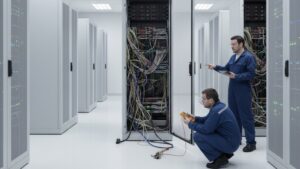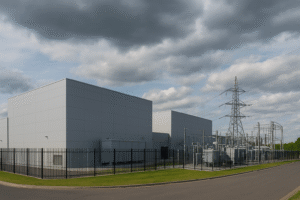The global race for constructing gigafactories is encountering an inconvenient challenge – materials sometimes lack availability at the right times. So, leading industries are presently forced to reassess their factory design premises. The strategies that proved successful the previous day may fail to deliver results moving into the future at a crucial moment. The massive financial commitments to these facilities and the clean energy transition make the pressure to get it right very high. This article discusses crucial breakthroughs in gigafactory designs, examines supply chain approaches and environmental initiatives that will drive market development.
Structural Adaptations in Gigafactory Designs
The material shortage situation requires facility planning processes and construction activities to develop innovative solutions. The subsequent part examines the innovative gigafactory design strategies for material shortages to reduce production limitations while maintaining operational effectiveness through scalability:
Hybrid Construction Techniques
Gigafactory facilities utilize hybrid construction methods that mix standard materials with substitute solutions for handling material supply changes. It includes engineered timber elements into steel structures and applying fiber-reinforced composites instead of aluminum. These combined materials systems enable companies to decrease their reliance on rare materials while offering multiple possibilities for supply procurement.
Hybrid construction methods improve structural reliability. This permits facilities to preserve operational efficiency during exposure to environmental stressors and operational demands. Manufacturers can also proceed with their timelines through unpredictable supply chain conditions because they utilize multiple accessible materials in their operations.
Compact and Scalable Designs
Material scarcity requires industrial operators to develop small-scale integrated production facilities. Manufacturers have adopted vertically integrated gigafactory designs to maximize their operations’ space utilization. The implementation of multi-level floors and modular assembly areas also enables production efficiency while decreasing the amount of needed material.
The flexible scalability of factory designs makes it possible for gigafactories to expand their capacity step by step as the material supplies improve. Businesses that build their operations through gradual phases can select key elements first to prevent extended deficiencies in raw materials.
Retrofitting Existing Infrastructure
Industrial manufacturers are choosing to convert existing production plants rather than building new facilities. The method gives way to less demand for new materials alongside the use of existing facilities to develop battery factories. The existing structural components present in buildings enable retrofitting projects to be completed more rapidly.
The reuse of facility space reduces the financial cost of development thus creating better economic possibilities for gigafactory construction. Upgraded insulation along with revamped HVAC systems and production lines in current buildings also creates manufacturing facilities that reach high operational efficiency levels without needing high amounts of resources.
Locally Sourced Construction Materials
The construction of gigafactories is now centering on obtaining building materials from nearby locations. It helps prevent the risks of worldwide supply network disruptions. It includes local cement replacements, recycled metals, and geopolymer concrete materials.
Construction within local areas makes transportation expenses more efficient and simultaneously strengthens local economic systems. Gigafactories attain supply chain stability through nearby material supplier investments. It also enables sustainable construction activities even during material shortages.
Supply Chain Strategies for Material Availability
Organizations need to develop efficient supply chain strategies for proper management of material shortages. This section describes the strategies in gigafactory designs to expand their procurement strategies alongside improved inventory management systems and long-term supply deals:
Strengthening Supplier Networks
Gigafactories advance their supplier networks to reduce their dependency on one independent supplier network. Multiple supplier connections across different geographical regions allow organizations to keep their material flow uninterrupted when certain global regions experience delivery disruptions.
The stability of operations comes from using long-term agreements together with co-investments established with critical material suppliers. The processing industry has started building direct mining partnerships to get priority in acquiring critical materials including lithium, nickel, and cobalt.
Blockchain for Supply Chain Transparency
Gigafactories deploy blockchain-based tracking systems as a solution against supply chain uncertainties. The digital ledger system boosts supply chain transparency. It supplies instantaneous information about the materials sourcing process and shipment progress as well as supplier performance tracking.
The verification feature within blockchain technology enables companies to prevent product manufacturing from unethical sources while stopping counterfeiting activities. The system allows manufacturers to guarantee conformity to regulations as well as generate precise data for better strategic decisions.
Vertical Integration of Raw Material Processing
Modern Gigafactories implement raw material processing within their facilities to navigate their supply chains better. A self-managed supply chain operation formed through this approach enables better control of materials and lessens supplier dependency.
Critical materials refining at the production site improves operational efficiency and provides a stable continuous supply of raw materials. By implementing one of the finest gigafactory designs, manufacturers achieve market-fluctuation resistance in addition to building sustainable manufacturing processes through cost-effective methods.
AI-Powered Demand Forecasting
The revolutionary movement of advanced AI has transformed the way companies forecast their material requirements and market trends. Future supply shortages can be detected in advance by AI systems. It scans market patterns together with historical information and worldwide threat factors.
Gigafactories using AI technology can modify their production planning to procure inventory in advance and optimize inventory management levels. The system enables organizations to reduce operational interruptions. Operation disruptions decrease as the determined strategy develops a durable supply chain infrastructure.
Sustainability-Driven Innovations in Gigafactory Designs
Sustainability functions as an essential element in developing gigafactories since businesses aim to combine effective resource use with environmental preservation. This section reviews how innovative sustainable gigafactory designs revolutionize the way gigafactories are being developed:
Carbon-Neutral Construction Practices
Gigafactory establishments are embracing carbon-neutral construction practices that work to decrease environmental effects. It includes sustainable steel substitutes along with low-carbon concrete as well as energy-efficient insulation materials. It cuts down emissions throughout the construction period.
Companies also utilize solar power generation systems and wind turbines at their facilities. It cancels out environmental impacts produced by their building process. So, the strategies meet global green targets in addition to satisfying current green building legislation standards.
Recycling and Upcycling of Industrial Waste
Recycling functions as a necessary solution to handle material shortages. The gigafactory industry is adopting circular economy practices for recycling production waste. It creates new building components from discarded materials.
Manufacturers cut down their use of virgin resources by turning industrial scrap into new end products for secondary purposes. Sorters and refinements equipped at high technological levels enable companies to extract precious metals from materials generated in battery production.
Water Conservation and Reuse Systems
Water scarcity represents a major challenge that directs the process of gigafactory designs. Gigafactory operators are installing self-contained water recovery systems. It lowers operation water usage along with lowering waste disposal requirements.
The combination of rainwater collection with filtration technology systems builds sustainability through alternate water supplies that support both cooling needs and production runs. So, long-term resource efficiency together with environmental conservation becomes possible through these implemented measures.
Smart Grid Integration for Energy Efficiency
Gigafactories are connecting to smart grid networks to improve the optimization of their energy usage. Real-time data provides facilities with the means to manage power consumption rates alongside demands which decreases their need for non-renewable resources.
Battery arrays installed onsite serve to smooth grid electricity usage while maintaining operational continuity when power consumption reaches its maximum level. So, the method boosts energy system resilience together with sustainable power adoption.
To Sum Up
Supply issues now modify gigafactory designs. It affects building methods, supply chain systems, and green initiatives. Manufacturers who build hybrid structures expand their supplier networks and integrate AI-based logistics systems will be better equipped to handle the evolution of material shortages effectively. Sustainability also acts as a fundamental approach to resource management. So, carbon-neutral construction, water conservation, and smart grid implementation must be pursued. Production efficiency in the battery industry thus depends on businesses incorporating these future-focused innovations.
A deeper exploration of these strategies can be found at the 2nd Gigafactory Summit which will take place on March 4-5, 2025 in Berlin Germany. The summit focuses on practical insights, case studies, and unmatched networking opportunities to keep you ahead. So, register right away!




